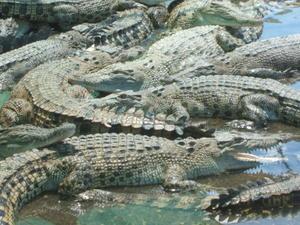Animals claim 23

Freeman Razemba Crime Reporter
TWENTY-THREE people have so far been killed this year after they were attacked by animals in separate incidents countrywide. According to statistics from Zimparks recorded between January and July 20 this year, 22 other people were also injured during the attacks. In a statement, Zimparks public relations manager Mr Tinashe Farawo said of the 23 people killed, 16 were killed by crocodiles, five by elephants, while lions and buffalo killed one each.
“Of the 22 who were injured, five were attacked by crocodiles, three by hippos, six by buffalo, seven by leopard, while the other one by a lion,” he said.
He said during the period under review, they received a total of 243 cases involving human-wildlife conflicts and they had managed to attend to 219 of these cases.
According to statistics, a total of 109 cattle were also attacked and killed by wild animals, while nine donkeys and 95 goats were also killed.
Of the 109 cattle, one was killed by crocodiles, 11 by hyenas, six by leopards, while 91 others by lions.
On goats, 46 were killed by lions, 20 by leopards, 28 by hyena and one by crocodiles.
Mr Farawo said on the nine donkeys, six were killed by lions and while the remainder was killed by crocodiles.
“The number of animals that were eliminated was 56 and these include crocodiles (14), elephants (eight), hippos (10), hyenas (six), buffalo (11), leopard (one) and six lions,” he said.
Of the 243 cases of attacks received by the parks authority, lions topped the list with 59, followed by hippos with 44, elephants had 41, crocodiles (37), buffalo (35), hyenas (nine), zebras (eight), leopards (six), snakes (two), while bush pigs and baboons recorded one case each.
According to Zimparks, cases in which lions attacked people did not happen often.
“Zimbabwe has wildlife in both open and fenced areas,” said Mr Farawo.
“Over 26 percent of the country’s land surface is under wildlife in gazetted wildlife areas, gazetted indigenous forests, some communal areas and private farms and conservancies.
“There is also wildlife in large tracks of unfenced areas under extensive management.”
Mr Farawo said when dealing with conflicts between people and animals, they normally captured and relocated the animals to conservancies and in some cases they eliminated them as a last resort.
“As Zimparks, we continue educating our communities and ensure that they inform the authorities if there are such cases within their environs,” he said.
“One of the main challenges we are facing is funding to ensure that we deal effectively with human -wildlife conflicts and also how to deal with nocturnal species that are active during the night.”









Comments